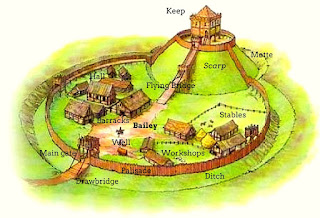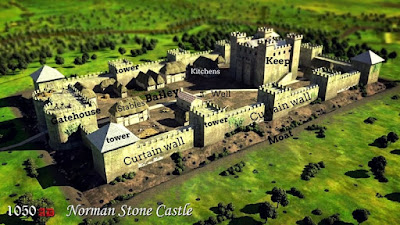The earliest castles were made from timber and earthworks, known as motte-and-bailey castles. The motte is a mound, either a convenient hill or a man-made one, with a defensive barrier and a tower (the keep) on top. The bailey is the area next to the motte enclosed by a fence and a ditch. Inside the bailey were the living quarters, hall, chapel, kitchens, stables and other buildings. If the castle was attacked everyone would withdraw from the bailey into the tower on the hill, which was more easily defended.
 |
| Motte-and-bailey castle (castlesworld) |
The advantages of the motte-and-bailey castle were they could be constructed quickly and easily with local material, and by unskilled labour. The Normans used them to consolidate their power after the conquest. They built almost 1000 castles in England, Scotland and Wales.
There were disadvantages too. The timber would rot and be expensive to maintain, and being combustible, fire arrows and fire throwing machines could easily burn them down. Of necessity the mottes were small, making accommodation in the keep very cramped. A better solution was needed.
 |
| shell keep castle [Restormel] (castlesworld) |
Motte-and-bailey castles were popular for 200 years but eventually builders began to replace the timber with stone, which was stronger, more durable, and fireproof. Initially, the timber structures were rebuilt in stone, but this didn’t solve the lack of space and engineers were concerned the motte wouldn’t support the greater weight of a stone keep. This castle is called a shell keep and was not popular for long. Soon people were becoming more ambitious.
 |
| Tower of London (pixabay) |
Stone buildings could be built much larger and more impressive. The first stone castle built in England and one of the first in Europe was the famous White Tower of the Tower of London. It was completed at the end of the 11th century, while traditional motte-and-bailey castles were still being built.
The World of Castles website says this about stone castles:
There were three crucial aspects that made stone castles desirable:
They were also immensely expensive. At a time when an expensive motte-and-bailey castle cost £20 to build, a stone castle could cost £10,000. And they still used timber for roofs and floors, which could rot and burn.
Below is a diagram of the typical layout of a stone castle, though the design depended very much on the terrain. We will be looking at the different parts of the castle as we follow this series.
 |
| (castlesworld) |
[adapted from The Medieval Castle Haynes Manual by Charles Phillips and The World of the Castle website]
Ann Marie Thomas is the author of four medieval history books, a surprisingly cheerful poetry collection about her 2010 stroke, and the science fiction series Flight of the Kestrel. Book one, Intruders, and book two Alien Secrets, are out now. Follow her at http://eepurl.com/bbOsyz